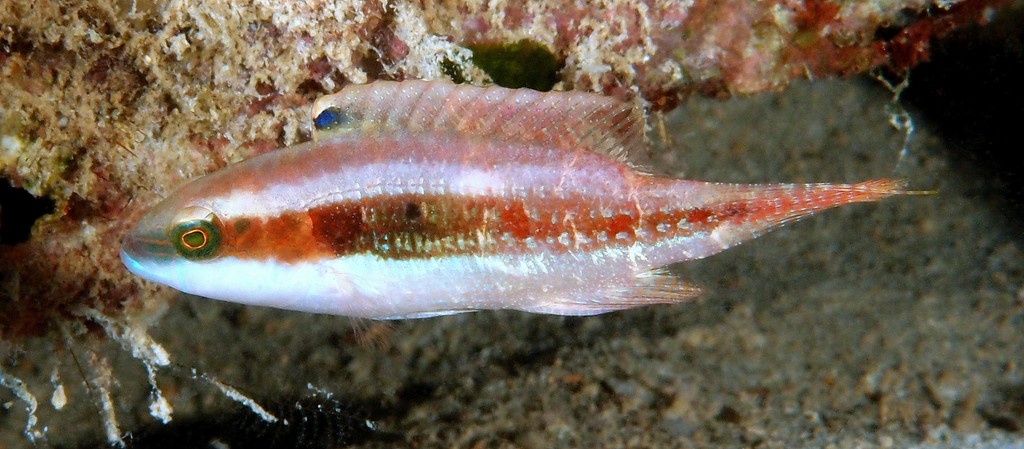OXYCHEILINUS BIMACULATUS - (VALENCIENNES, 1840)
Actinopterygii (Gigaclass) > Actinopteri (Class) > Teleostei (Subclass) > Labriformes (Order) > Labroidei (Suborder) > Labridae (Family) > Oxycheilinus (Genus)
Labre à deux taches, Madame tombée, Labre à queue de comète, Comettailed wrasse, Doublespot wrasse, Little maori wrasse, Two-spot wrasse, Twospot maori wrasse, Tweekol-lipvis, Takobera, タコベラ, 双斑尖唇鱼,
Synonymes
Cheilinus bifasciatus (Bleeker, 1871)
Cheilinus bimaculatus (Valenciennes, 1840)
Cheilinus ceramensis (Bleeker, 1852)
Cheilinus melanopleura (Bleeker, 1865)
Cheilinus mossambicus (Günther, 1862)
--------------------------------------------
Description
Dorsal spines (total): 9; Dorsal soft rays (total): 10-11; Anal spines: 3; Anal soft rays: 8; Lateral line interrupted, the pored scales in upper anteriro series: 15-16 and those in midlateral series on causal peduncle: 6-7; Head scaled except snout, chin, and anterior interorbital space; Body depth: 2.6-3.1 in SL; Dorsal profil of head slightly convex; Mouth terminal or lower jaw slightly projecting; Preopercular margin smooth; Caudal fin rounded in female. Caudal fin of terminal males rhomboid, with central rays longest, and dorsalmost caudal-fin ray elongated into a short filament. Max. length: 15.0 cm TL. Depth range: 2 - 110 m.
Color
Body variable from brown to yellow or green mixed with various color shades or spots. Young with a broad, dark lateral stripe which breaks into dark blotches in adults, the largest above distal pectoral fins. A dark brown blotch on side above pectoral fin, sometime followed by three less distinct blotches; A small dark green spot behind eye and one on first dorsal fin membrane; Orange line radiating from eye.
Etymology
Oxycheilinus: from Greek, oxys = sharp + from Greek, cheilos = lip.
bimaculatus: from Latin prefix, bi- = having two parts, occurring twice + from Latin, macula, -ae = stain, spot.
Original description: Cheilinus bimaculatus Valenciennes, 1840 - Type locality: Honolulu, Oahu Island, Hawaiian Islands.
Distribution
Red Sea, Indo-West Pacific: East Africa, Socotra, Seychelles, Madagascar and Mascarenes east to Hawaiian Islands, north to southern Japan, south to Lord Howe Island and New Caledonia, and Marquesas Islands.
Biology
Inhabits outer reef slopes or deep clear lagoons among rubble or clumps of algae; Also in seagrass beds. Often in sheltered estuaries and harbors. Benthic and benthopelagic.
Labre à deux taches, Madame tombée, Labre à queue de comète, Comettailed wrasse, Doublespot wrasse, Little maori wrasse, Two-spot wrasse, Twospot maori wrasse, Tweekol-lipvis, Takobera, タコベラ, 双斑尖唇鱼,
Synonymes
Cheilinus bifasciatus (Bleeker, 1871)
Cheilinus bimaculatus (Valenciennes, 1840)
Cheilinus ceramensis (Bleeker, 1852)
Cheilinus melanopleura (Bleeker, 1865)
Cheilinus mossambicus (Günther, 1862)
--------------------------------------------
Description
Dorsal spines (total): 9; Dorsal soft rays (total): 10-11; Anal spines: 3; Anal soft rays: 8; Lateral line interrupted, the pored scales in upper anteriro series: 15-16 and those in midlateral series on causal peduncle: 6-7; Head scaled except snout, chin, and anterior interorbital space; Body depth: 2.6-3.1 in SL; Dorsal profil of head slightly convex; Mouth terminal or lower jaw slightly projecting; Preopercular margin smooth; Caudal fin rounded in female. Caudal fin of terminal males rhomboid, with central rays longest, and dorsalmost caudal-fin ray elongated into a short filament. Max. length: 15.0 cm TL. Depth range: 2 - 110 m.
Color
Body variable from brown to yellow or green mixed with various color shades or spots. Young with a broad, dark lateral stripe which breaks into dark blotches in adults, the largest above distal pectoral fins. A dark brown blotch on side above pectoral fin, sometime followed by three less distinct blotches; A small dark green spot behind eye and one on first dorsal fin membrane; Orange line radiating from eye.
Etymology
Oxycheilinus: from Greek, oxys = sharp + from Greek, cheilos = lip.
bimaculatus: from Latin prefix, bi- = having two parts, occurring twice + from Latin, macula, -ae = stain, spot.
Original description: Cheilinus bimaculatus Valenciennes, 1840 - Type locality: Honolulu, Oahu Island, Hawaiian Islands.
Distribution
Red Sea, Indo-West Pacific: East Africa, Socotra, Seychelles, Madagascar and Mascarenes east to Hawaiian Islands, north to southern Japan, south to Lord Howe Island and New Caledonia, and Marquesas Islands.
Biology
Inhabits outer reef slopes or deep clear lagoons among rubble or clumps of algae; Also in seagrass beds. Often in sheltered estuaries and harbors. Benthic and benthopelagic.
Similar species
Cheilinus oxycephalus (Bleeker, 1853) - Reported from New Caledonia - Link to the species (here). Brownish red, mottled with small whitish spots; Dark brown spot anteriorly on each side of upper lip; Two dark lines diverging from the eye; Dark brown spot on 1st two dorsal membranes. Deep-bodied for genus, and snout pointed. Max. length: 17.0 cm TL.
Cheilinus oxycephalus (Bleeker, 1853) - Reported from New Caledonia - Link to the species (here). Brownish red, mottled with small whitish spots; Dark brown spot anteriorly on each side of upper lip; Two dark lines diverging from the eye; Dark brown spot on 1st two dorsal membranes. Deep-bodied for genus, and snout pointed. Max. length: 17.0 cm TL.
